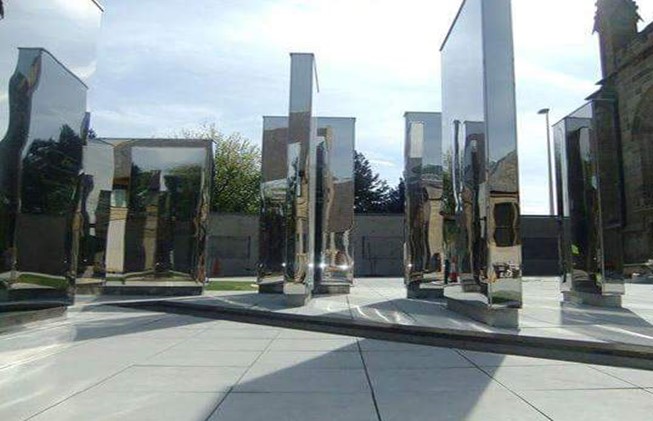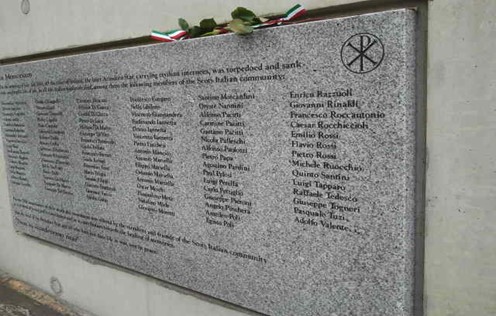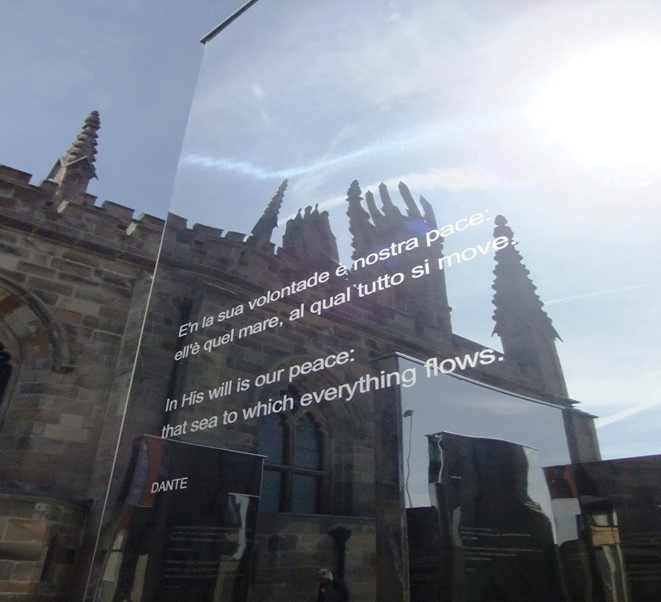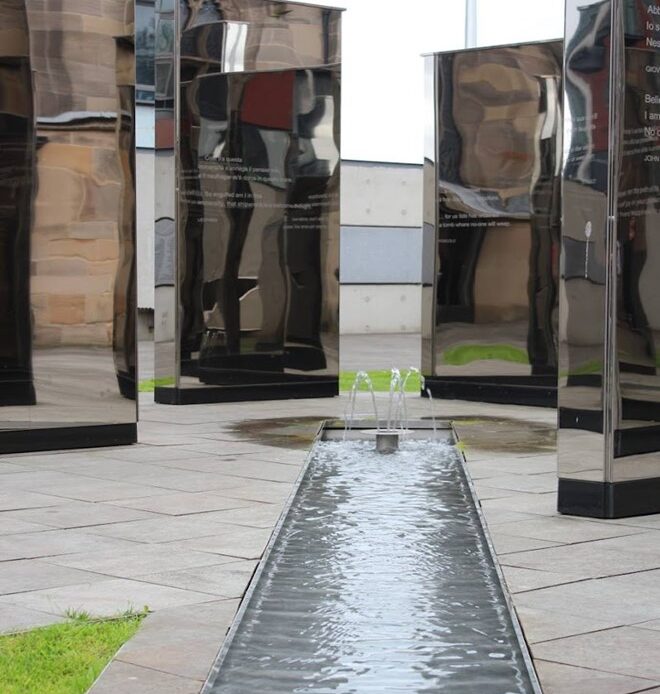
Welcome to the Italian Garden!
I must apologise if you were expecting a formal garden with flowers, plants, trees and bushes but as you can see it is not that type of garden, – it is because this is a Memorial Garden.
It is a memorial to the men who died on a ship called The Arandora Star and a tragedy that has almost been forgotten and in many ways remains unknown.
The story of this Garden starts in 1940 – the 10th June to be exact. That is the day that Italy, under the leadership of Benito Mussolini declared war on Britain and France and entered the Second World War on the side of Nazi Germany and Hitler.
Italy had been an ally of Britain in World War 1 and this declaration of war was taken as a personal insult to the British government, so much so that Winston Churchill immediately and famously decreed “Collar the Lot” – meaning that every Italian male living in Britain between the ages of 16 -70 were to be arrested and imprisoned. Over the course of the next three weeks in a very haphazard way, Italian men living in Britain were duly arrested and held in prisons and makeshift internment camps throughout Britain as they were now all classed as Enemy Aliens. (Enemy Aliens – people already living in that country when their home country declares war on that country.)
Some of these internment camps were nothing more than fields surrounded by barbed war and patrolled by armed guards, others were actual prisons and others were hastily adapted buildings. The first phase of men was eventually moved to one of the main holding locations which was the notorious Warth Mill near Bury.
The inmates had no beds, just wooden boards or they slept on the floor with little or no bedding. There was no heating and no electricity. 2,000 people were at Warth in 1940 with reportedly access to just 18 water taps and only one bathtub. There were no toilets – just some buckets in the yard.
The place was rat infested, the food scarce and vile, and prisoners had to eat standing up because there were no tables. The roof leaked rain, the inmates were denied medicine and medical treatment and received no information about their families.
(Conditions were so bad at Warth Mills that the Red Cross later condemned the camp as unfit for habitation. It then ceased to be an internment camp and instead became a Prisoner of War camp after being ‘reconditioned’.)
To add to the internees’ misery, the guards confiscated many of their personal affects and indeed stole from them – the Commandant, a Major A J Braybrook with the Territorial Army was later convicted (July 25, 1941) of stealing money and property to the value of between fifty and sixty thousand pounds.
Winston Churchill and the British war cabinet had drastically underestimated the number of internees arrested, and whose numbers had now been swelled with Germans and Austrians and some Jews who had already been forced to flee mainland Europe.
It was decided that help from other parts of the (then) British empire would be sought and both Canada and Australia “agreed” to accept some of these “enemy aliens”.
But the only way to transport these men was of course by sea and so several ships were requisitioned into the war. One of these ships was the very famous cruise liner – The Arandora Star. She had been one of the world’s most luxurious and famous cruise ships throughout the 1930s, and I will not be able to fully describe to you the opulence and splendour of this ship – this ship was very special during the 1930s – it sailed on cruises to some of the most exotic locations of the world – and of course only the very rich (and famous) could afford to go cruising at that time. This ship was 10 times more luxurious than the Titanic, and it was 20 years more modern. Just to give you a real comparison – Leonardo di Caprio playing the part of the poor Jack in the famous film would never have been allowed on the Arandora Star because it was so exclusive and famous and as it only took 1st Class passengers (400 passengers to 350 crew).
This was at the time when cruising could last weeks or months and for those who could afford such luxury and opulence. Every night the ladies on board would dress for dinner in formal wear of gowns and dresses and the men were in evening or dinner suits and bowties.

But that was NOT the ship that docked at Liverpool on Monday1st July. It had been stripped of all its beautiful fittings and opulence, everything of beauty and decorative appearance had been stripped out, and the ship had been painted battleship grey and the deck rails had been wrapped with barbed wire. This was how this once most beautiful ship arrived in Liverpool dock. 1,216 internees, many of whom would have been at Warth Mill, boarded the SS Arandora Star on the same night, and the ship sailed on the late tide.
She was unmarked, and un-escorted. No lifeboat drills were held, so even the crew was not immediately familiar with the ship’s layout, let alone the passengers aware of what to do in an emergency. Many of the internees were middle-aged or elderly and did not know how to swim. She headed north up the Irish sea around the top of Ireland and was ready to sail across the North Atlantic to Canada. Early the next morning she was spotted by the German U-boat 147 captained by the famous Gunther Prien who fired a single torpedo that struck her. Prien had believed the torpedo to be faulty, but it detonated against Arandora Star’s starboard side, flooding her aft and causing her to sink.
Panic and chaos set among the passengers, who were coaxed to jump into the sea and swim to life-rafts thrown to the side and not to hamper the crew’s effort to lower lifeboats. While some prisoners climbed down the ladders to get to the lifeboats, many, mostly Italians, clung to the ship waiting for a place in lifeboats. They were afraid to take life-rafts as one Army Captain said that only British people would be allowed on board (however, Third Officer W. H. Tulip ordered to save everyone regardless of their nationality).
Captain Moulton, 12 officers and 42 crew (55 of 174), 37 of the 200 military guards, 243 of the 479 German, Austrians and Jews onboard and 470 of the 734 Italian internees drowned. The remaining 868 survived and were eventually rescued by the Canadian destroyer the St Laurent.

The central mirrored plinths are the centrepiece of the Memorial and are dedicated to ALL 805 men who perished when the Arandora Star sank approximately 75 miles west of Bloody Foreland, Ireland, on the morning of 2nd July 1940.
Of the 446 Italians who died, 94 of them were from Scotland. They are individually listed on the central plaque on the east wall of the garden.

For 84 years the families of all those men who lost their lives had no death certificate as they were “enemy aliens.” Many of the bodies did wash up on the coasts of Ireland and on the Outer Hebridean islands, and a very few could be identified from clues on the bodies, or from their clothing or personal items but the majority could not be identified. Immense credit must go to those people on the Irish coast and the Hebridean islands who, when they recovered these bodies gave each of them a Christian burial.
The garden was designed by the Roman architect Guilia Chirani, and what you see is her interpretation of a fitting memorial to the tragedy. The central mirrored plinths are of different heights and look like exaggerated gravestones. I mentioned earlier that the ship had been stripped of its finery and the only hint of luxury that had remained were the mirrored walls that decorated the grand ballroom, the largest space onboard the ship. It is this feature that has been used, the design is a representation of the shattering of this once magnificent ship as the torpedo exploded and the loss of life occurred – not a nice image to hold when you think of all those men who perished – and then the water feature – long and narrow representing the path of the torpedo and the water fountain represents the explosion – even the water on the slabs adds to the imagery of the water entering the ship and those men running across the floor and decking with water coming into the ship but Guilia countered this with her interpretation – that as you enter the structure you are struck by several features – firstly the plinths act as sound proofing to the busy street outside and then you notice the mirrored plinths are not true mirrors, they actually distort the images you see –so you don’t see yourself in the usual way you see in your mirror – and then you notice the words and phrases inscribed on the mirrored plinths quotes and sayings from the bible and from famous Italian writers and poets all relating to death and the sea.

… and then you see and hear the water and see the little fountain which gives you a further feeling of peace and tranquillity and a chance to reflect in on yourself or a sense of peace.

This imagery is also reflected when you see the harsh urban grey walls of the garden. Question – Can you see what it may depict? – well it is a further image of this once magnificent ship being painted battleship grey and the imagery is further emphasised on the outside of the walls of the garden that are brown and pink marble and granite representing the once beauty of The Arandora Star.
It is our fear that some visitors would come into the garden and shrug when they see some nice mirrored blocks and a small water feature with a plaque of strange sounding Italian names on a wall and go away – but hopefully telling you about the tragedy of The Arandora Star and explaining the design and imagery of the garden, you have learned a wee bit about the story and that you understand and appreciate the Italian Garden and Arandora Star Memorial.
The Arandora Star Memorial Garden or Italian Cloister Garden is next to St. Andrews’ Metropolitan Cathedral at 196 Clyde Street Glasgow G1 4JY.
Raffaello Gonnella
Member of Arandora Star Project AS94
Trustee of ItalianScotland Charity
Member of Glasgow Italian garden and Arandora Star Memorial Group
Project AS94
If anyone can help Raffaelo in trying to trace the family of the 94 Italian men from Scotland who died in the tragedy of the Arandora Star on 2nd July 1940, in particular:
Guido Ferrari No. 42 Born: 01.09.1893 from Valdena (PR) arrested Kirkcaldy
and
Orazio Iannetta No. 54 Born: 25.08.1901 from Belmonte Castello (FR) arrested Methil
Any family contact would be a massive help, and Raffaelo can be contacted on a1gon@aol.com
